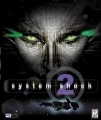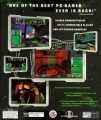System Shock 2
First posted on 15 July 2006. Last updated on 09 August 2009.
System Shock 2 is the sequel to the sleeper hit System Shock. True to its name, the sequel brings forth another epic fight against a new army of mutants, robots, and cyborgs. As with the original game, you and your cybernetic implants stand as the last chance between humanity and its destruction. Again, a corrupted AI is killing everyone around you and you are charged with the mission to destroy it. This time, there is a wider array of weapons, upgrades, and psychic powers at your disposal to aid your quest to fight the enemies and stay alive.
The story begins when you wake up from a cryogenic slumber on board the UNN flagship Von Braun, a new space ship built by the powerful TriOptimum Corporation that is responsible for the rogue AI SHODAN in System Shock. Dr Janice Polito, Von Braun's Senior Systems Analyst, informs you that you have volunteered for the implantation of a new cybernetic interface but there has been a problem restoring your memory during the rehabilitation from the procedure. Furthermore, an evil force has since overtaken the Von Braun and you are told to meet her at Deck 4 to discuss a further plan of action. To do this, you must first restore power to the elevator and then free the blocked elevator shaft at Deck 3. Reading the logs and emails left scattered around the ship, you discover that both your ship and the UNN Rickenbacker have been infected by mutagenic microorganisms from Tau Ceti 5 called the Many. These life forms possess some kind of collective intelligence and have overtaken the XERXES, the Von Braun's AI, to gain control of its robots and most of the ship's systems. Eventually, you meet up with SHODAN to learn that the Many are seeking revenge against SHODAN and others who have brought on their existence. You and SHODAN must now work together to defeat XERXES and the Many, after which you engage in a final showdown against SHODAN.
The game uses an enhanced version of the Dark Engine originally developed for Thief: The Dark Project. Movements within the game world are controlled using the keyboard, whereas moving the mouse changes the view of the game world. Left clicking the mouse button fires a weapon and right clicking the mouse button manipulates an object from the game world or the inventory. Notwithstanding a few differences, the interface is similar for the most parts to the interface used in the original System Shock (such as marking active items with brackets instead of highlighting them and showing the remaining hit points of your enemies with colored bars above their brackets). However, the inventory system is more robust in the sequel.
You begin the game by choosing your character from among 3 services—Marines, Navy, and OSA, with specialized skills in physical combat, technology, and psychic power respectively. There are 2 modes of play. The first is the shooting mode, where you use the mouse to look around the environment from a first person perspective. The second is the interaction mode, where you use the cursor to pick up objects, rearrange the inventory, swap weapons, and perform other actions. You change from shooting mode to inventory mode by right clicking on an object which can be manipulated, such as a numeric keypad, a container, a vending machine, and even a dead body. Conversely, you change from inventory mode to shooting mode by left clicking anywhere outside your inventory. You can also press the tab button to quickly alternative between these modes.
There are a few key gameplay differences between the original and this sequel. The major difference is the system for character development. While the only character development allowable in the original game is an upgrade to better weaponry or armor, character development in this game uses a complex system that is based on 3 skills (4 weapon skills, 5 technical skills, 5 tiers of 7 PSI skills) and 5 statistics (Strength, Agility, Endurance, Psionics, Cyber Affinity). You improve your character through upgrades with cybernetic modules. SHODAN sends you some modules upon completion of major quests as the game progresses, but you can also find some modules lying around the ship decks or with the dead crewmembers' bodies. The other difference is the implementation of a monetary system. Payment is required for using vending machines, healing, hacking, repairing or modifying items, and reviving your body each time you die. These payments are made using nanites which can be found nearly everywhere in the game.
An element which I miss playing this sequel is the fight in Cyberspace that is so prominent in the original. In addition, the ship decks appear to be too big to be loaded in its entirety into the computer's system memory, so that bulkhead doors are artificially placed within the game environment to denote new areas which then need to be loaded whenever they are entered. Unfortunately, while saving a game is done very quickly, loading a game often takes a long time. This can be frustrating and time consuming, for example, if you have to cross more than a single area at a time to get to a healing station.
The engine used in this game is well optimized. There is virtually no lag when viewing the game world in full screen. Learning the complex interface can be a daunting task initially, but there is a short training mission available to familiarize yourself with it before you are asked to choose a career at the start of the game. The manual also contains a quick reference to movement keys such as ducking and strafing. Nearly every function in the game is mapped to a hotkey. This is important since the ability to make a quick change between a PSI power and a melee weapon can often mean the difference between life and death.
This can be a challenging game. There are 4 difficulty settings—Easy, Normal, Hard, and Impossible. All the enemies respawn very quickly in this game. There are many instances where you sneak to the edge of a room you have just cleaned to peek around the corner to check out for the automatic turrets and then suddenly wake up at the Bio-Reconstructor half a deck away because a hybrid has come out of the supposedly empty room and kill you from behind. If you choose to play the game hardcore without the option to be revived, you may end up spending a lot of time waiting for your saved games to reload. Fortunately, you can adjust the level of difficulty in mid game.
A minor quibble I have with this game is the uneven pace over which the story is unfolded. Some gamers may enjoy being kept in the dark of the main storyline until the very end, but not for me. By the time you meet SHODAN to learn about the true identity of your enemy and your ultimate mission, half of the game is already over. Moreover, the reasons given to you as to why SHODAN helps you and why you must help SHODAN in return are not very logical. The end fight between you and SHODAN also seems out of place.
Despite the complex interface and the convoluted storytelling, System Shock 2 is still a worthy sequel to System Shock. The game looks polished and plays well. As with the original, the sequel combines a good mix of action, role-playing, and adventure, to the extent that any fan of these genres can find enjoyment in this game.






